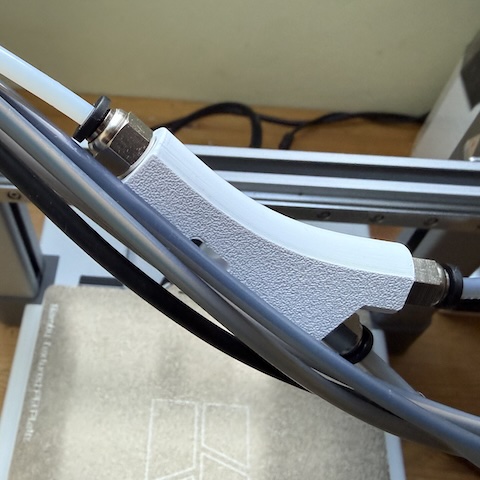A 3D Year

A year ago, I got a 3D printer. A year later, is it gathering dust, or am I still using it?
I’m happy to report, while it’s not quite as busy as it was for the first few weeks, it is still in regular use. While I’ve made quite a few posts over the year (collected at the end of this one), I thought it might be interesting to look back and see what kinds of things I’ve been using it for.

One obvious category (indeed, the thing the printer is doing as I type this) is toys. This was the original impetus for pushing the button on a 3D printer. Specifically, articulated dragons — our youngest in particular loves these. While they’re cool in their way, if this was all the girls were using the printer for I’d be disappointed. However, they’ve been substantially more creative, in particular with doll’s furniture and accessories. The eldest has got very into TinkerCad, and has custom designed numerous pieces, the most ambitious being a working wheelchair for a doll with a broken leg. HeroForge is also proving a hit.

Another cliché is that the main use of 3D printers is to print accessories for 3D printers, and I’ve done my fair share of that. Along with the usual scrapers and buckets, I’ve printed out quite a few mounts for hygrometers1, and most recently a Y-splitter to allow me to keep the external spool connected at the same time as the AMS. Printing things to better print things is a bit circular, but a nice fringe benefit.
I’ve also found it surprisingly useful for things around the house. Sometimes I find myself printing out things that are better and cheaper mass-produced, like curtain hooks. The benefit of using the printer is that you can get one or two rather than buying an entire pack, and you can get it in ten minutes rather than making a trip to the shops. More often, though, I’m printing something that I couldn’t buy, as it’s custom designed to meet a specific need. An example would be the wall mount for our kitchen scales — we have something that exactly fits the scales we have, and the location where we want to put it. I’ve picked up enough basic CAD skills (OpenSCAD and FreeCAD) that I can create pieces to solve particular problems without too much effort, and doing so is immensely satisfying.

I recently got a Skadis pegboard to display some of my retro computing bits and pieces. 3D printing is the ideal way to get mounting hooks and other attachment to support things of all shapes and sizes, either designed from scratch, downloaded from communities like Thingiverse and Makerworld (where Skadis accessories are a thriving subgenre), or a custom combination of the two. I can see retro computing being another area where the ability to make custom 3D printed parts will be handy; I’ve only done one project in this vein so far, but I can see more on the horizon.
One thing that I’ve not used the printer for much, at least yet, is making parts for keyboards. I’ve made keycaps, but I’ve just not been able devote the time needed for a bigger project. Hopefully, I will soon.
Overall, I’m glad that our 3D printer has continued to prove its worth. It’s not in action every day, or even every week, but it’s great to have on hand, and I certainly don’t regret taking the plunge.
3D printing posts this year:
- 17 Nov 2024: Adventures in the Third Dimension
- 23 Nov 2024: Multicolour Waste
- 29 Nov 2024: First Functional Print
- 22 Dec 2024: The Cat is Lying To You
- 24 Dec 2024: Deck the Halls
- 4 Jan 2025: Keyboard Tray and FreeCAD
- 12 Jan 2025: You Wouldn't Steal a Boat
- 31 Jan 2025: Three Shots
- 18 Jul 2025: Coffee Cup Sleeve
- 10 Aug 2025: Miniature, Maxiature
- 3 Sep 2025: A Customisable Cable Clip
- 19 Oct 2025: A New Material
-
3D printer filaments are, to a greater or lesser extent, sensitive to humidity, so unless you live in the Sahara you need to keep an eye on it, especially for storage. [back]


